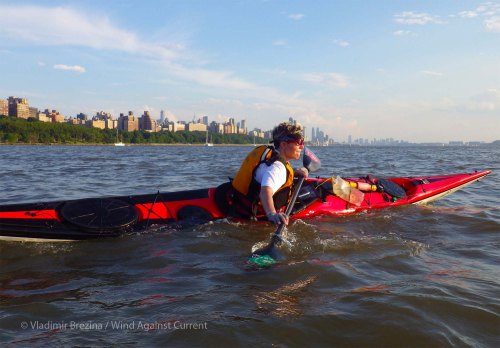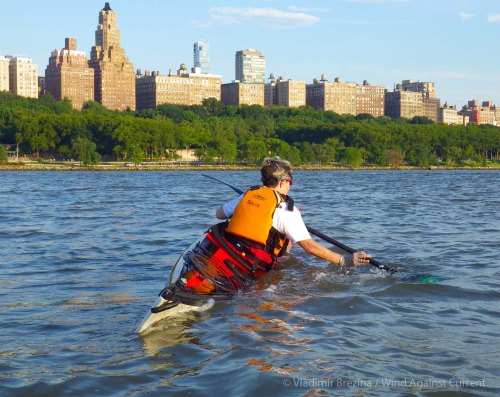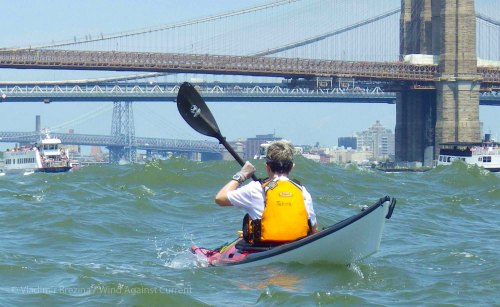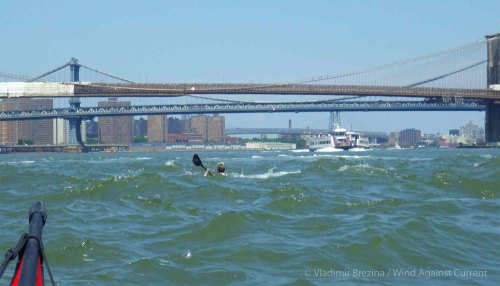By Johna Till Johnson
Photos by Vladimir Brezina
Even though I’ve now passed the BCU three-star exam, I’ve decided to spend this summer working on boat-maneuvering skills. Truth is, while I’m pretty strong at some aspects—like group management, comfort in wind and waves, and basic navigation—I could use some improvement in boat-handling.
So a few days ago, I was practicing sculling for support in the Pier40 embayment.
Sculling for support entails putting the boat on edge, leaning out over the water, and staying upright by slowly sweeping the paddle blade back and forth parallel to the side of the boat.
My friend Adam is fantastic at it—he can lean out almost horizontal to the water. Me, not so much. But I’m learning.
Part of the challenge is that to do it correctly, you really need to send the boat off-balance. As one of my coaches put it succinctly, “If you want to know whether you’re doing it right, stop sculling. If you capsize, you were doing it right.”
It’s kind of an interesting maneuver, because it’s strictly intentional. Unlike bracing, turning, or rolling, you don’t do it as a reaction to a particular incentive, like being about to capsize, needing to change direction, or having actually capsized.
You have to make the choice to scull for support.
And when do you choose to scull for support?
On our recent Manhattan circumnavigation, I found myself wondering exactly that. We had just passed the Battery and were in the lower East River, where the shift in currents, combined with the wakes of ferry boats and other commercial vessels was making the water exceptionally choppy, as usual.
“Hmm…” I thought to myself. “When would I actually use sculling for support?”
Obviously, the purpose of the stroke is to stay upright while stationary in treacherous water. But when might that particular scenario arise? As a sea kayaker, I’m usually focused on moving forward.
And that goes double in treacherous water. Momentum equals maneuverability—my natural response to instability is to paddle the boat faster so I can get maximum maneuverability.
When would I possibly want to simply remain upright in place?
Just then, Vlad called called out, “Hold up! Let’s wait until the ferry docks!”
And there I was, attempting to remain stationary in three-foot waves.
The lightbulb went off. When, indeed?
I immediately started in with my newly-practiced skill, and stayed comfortably upright while the ferry did its thing.
Funny: All these years I knew in the abstract what sculling for support was for. But it took until that day to recognize when to use it!








I am so impressed Johna. The last photo made my hair stand up on the back of my neck!! Bravo and LOVED your life jacket. Great story and better skills. (she said from the deck of the boat)
LikeLike
Thanks! Actually, that last photo is one of the few that actually captures the conditions–the problem is that when conditions are seriously, ahem, “interesting”—the photographer is too busy paddling to capture photographic evidence.
LikeLike
It was a brilliant capture !
LikeLike
Excuse me, Johna! The photographer is in a Feathercraft, which makes all kinds of things possible! ;-)
LikeLike
HAHAHAAA Vlad!
LikeLike
An amazing sport and quite a story. Thanks!!
LikeLike
Thanks!
LikeLike
I have trouble staying on the raft in the kiddie pool. I’d last 5 minutes in a kayak! Love reading your adventures though!
LikeLike
Hey, you never know what you can do until you try! Thanks for posting…
LikeLike
Nice photos and a great skill that so few paddlers practice regularly. I found the best way to get the body position correct, is to rotate the body towards the sculling side (look at the paddle !!). This raises the offside knee into the correct position, drives the butt into the seat and opens the chest so that the paddle shaft is not cramped against the body. A necessary skill if you are like me and often paddling a surf kayak that is more than a little unstable at rest.. a slow skull is really the best stroke to use when waiting for the next wave set.
LikeLike
Ah, Ian, you’re just being polite.. I know my form is not what it should be in those photos (and those were the BEST of the bunch that Vlad took). I don’t know you well enough to share the mental image my coach provided to me… all I can say is I should be much more parallel to the water (as you write) and MUCH farther down! (yes, LOOK AT THE PADDLE!)
I will get there, though.
Thanks for commenting!
LikeLike
Ian, thanks again for the tip. I used it today (07/07) while on our trip to Sandy Hook. Thinking about rotating my hips towards the side of the boat helped quite a bit.
LikeLike
congratulations! what a great story! z
LikeLike
Thanks!
LikeLike
awesome photos. I like the one with the ferry.
LikeLike
I’m glad! Vlad complained when I originally took that one out… so back in it went, and I’m glad it did!
LikeLike
I am so impressed you have photos to share from those conditions! I almost took a swim from my Stand Up Paddle board last weekend when trying to take pictures as a wake snuck up on me from behind…
Lisa
LikeLike
Hi Lisa!
Yes, taking photos tests your skills in a whole new way. That said, capsizing from a SUP is half the fun–no fancy rescue maneuvers, you just get back on board!
LikeLike
So true. :)
LikeLike
It’s like that with everything – doing it in real life teaches you things you don’t learn in practice. Glad you got it figured out! I’m impressed with your sharing of how you’re learning to do this and your strong / weak points. I know, I’ve said it before, but so few people own up to what it takes to be proficient in something.
And the photographer was obviously quite gifted to catch that last shot, although apparently his Feathercraft was a considerable advantage. I will now exit laughing.
Nancy
LikeLike
The photographer is absolutely amazing (and yes, the Feathercraft helps), but he’s damn good!
And yes–I’m not at all embarrassed to be constantly learning this kayaking thing. As I told a friend years ago–I took it up precisely because I was NOT innately talented at it. I was (am) at a time in my life when I want(ed) the challenge of doing something I’m not good at…..and am loving the whole process of *becoming* good. Or better, at least.
Thanks for posting!
LikeLike
I am in awe of you and your courage. The skill and determination you have is wonderful. No doubt you will accomplish you goal by the end of summer. Thanks for sharing your exciting adventures.
LikeLike
I sure will try, Mountain Gypsy! Thanks for the encouragement—it’s always great to hear from a fellow adventuress (should that be “fella”?)
LikeLike
Impressive! We are such casual paddlers for relaxation & enjoying the wildlife and tend to avoid the things that might tip us over.
LikeLike
Hey, there’s no “right” way to paddle—yet another thing I love about the sport. Absolutely nothing wrong with paddling to see the wildlife… or fish…or rocket down whitewhater… whatever flips your bits!
Thanks for posting!
LikeLike
I’m in awe! That takes much of the courage to do what you do.
LikeLike
Thanks! But honestly, it’s not that scary (most of the time, anyway!) Thanks for posting!
LikeLike
Interesting post, Vlad, and great pics. It certainly sounds very tricky.
LikeLike
Thanks! And I agree on the photos–Vlad always manages to do a great job, I have no idea how!
LikeLike
Yes he does, Johna, but without you, they just wouldn’t be the same. :)
LikeLike
I quite agree :-)
LikeLike
All Johna this time—I just supplied a few photos that fit the theme :-)
LikeLike
Two words: Go Pro! :-).
Sculling done improperly can also really hurt a shoulder (rotator). :-). And, I learned, it is a bit different than in a canoe!
I wish we had big water. Enjoy!!!
LikeLike
I’m actually pretty good about keeping things “inside the box” so I don’t damage my shoulders. One benefit of not having had much upper-body strength growing up is that I never learned to count on it–so by the time I actually got some, I knew better than to abuse it.
Thanks for posting!
LikeLike
:-). Yup.
LikeLike
Have a GoPro, just haven’t used it much yet—but I think that will change :-)
LikeLike
Great story, Johna. I think I remember you talking previously about being afraid of those rolls; so, did you test your sculling by seeing if you would roll? Just curious :-)
LikeLike
Ummmm… this is the point where I say, “who ME? Afraid of rolling? NAAAAH!”
And it would ALMOST be true :-).
To answer your question, I’m pretty much not afraid of rolling (intentionally) any more. And I have managed to pull off a “combat” roll (wave knocks you down unexpectedly, you roll to get up).
All that said, I still have a bit of reluctance to do things like bracing and sculling that might end up requiring a roll. That’s why I’m practicing this summer–to get over that reluctance.
So yes, every now and then I fall in and roll to get up!
LikeLike
Very interesting read!And with good photos to go with it too! What was the temparature in the water?
LikeLike
It varies depending on the NY waterway. In the Hudson it’s already in the low 70s–in the East River (which gets more water from the Atlantic Ocean), it’s still in the 60s. Either way, quite comfortable on the 90+ degree days we’re now having in NYC!
LikeLike
Nice work, Johna! That was some rough water, I’d better get my Dramamine.
LikeLike
Thank you! And actually, it looks more dramatic than it felt at the time. Summer is always interesting in New York–the boat wakes make for some dramatic visuals, but it’s not as if it’s an ocean swell packing the full force of 2,000 miles of energy.
LikeLike
I grew up in NY and I can’t imagine being willing to navigate those waters in a tiny craft. YIKES. At least the water looks less like pudding than it did when I was growing up. That’s something. You are very brave, my friend.
LikeLike
Isn’t it amazing that the water is so clear and (relatively) fresh?!? Hard to believe that something got better since we were kids!
Thanks for reading, and posting!
LikeLike
Great shots. Congrats on getting to use your “why would I use this” method of sculling. But whoa! That is way too scary for me.
LikeLike
Not scary at all, actually–sculling is one of those things you can just “ease” into, strange as it sounds.
And yes, Vlad’s photos are fantastic!
Thanks for posting!
LikeLike
Ah but not being a swimmer, I doth protest. :-D (haha)
LikeLike
The Eskimos, who invented kayaking, couldn’t swim either… ;-)
LikeLike
Well alrighty then! ;-)
LikeLike
Reading your archives again. My goal this year is to learn a few more rolls, paddle work (such as sculling), and more self-rescue practicing in both calm and rough seas.
I just received my handcrafted Greenland paddles, including a storm paddle. (I wish had that one on my last trip.) I need to learn how to put them to good use = more motivation.
Great post as usual.
LikeLike
Now that the summer is almost over, how did these plans work out? :-)
LikeLike